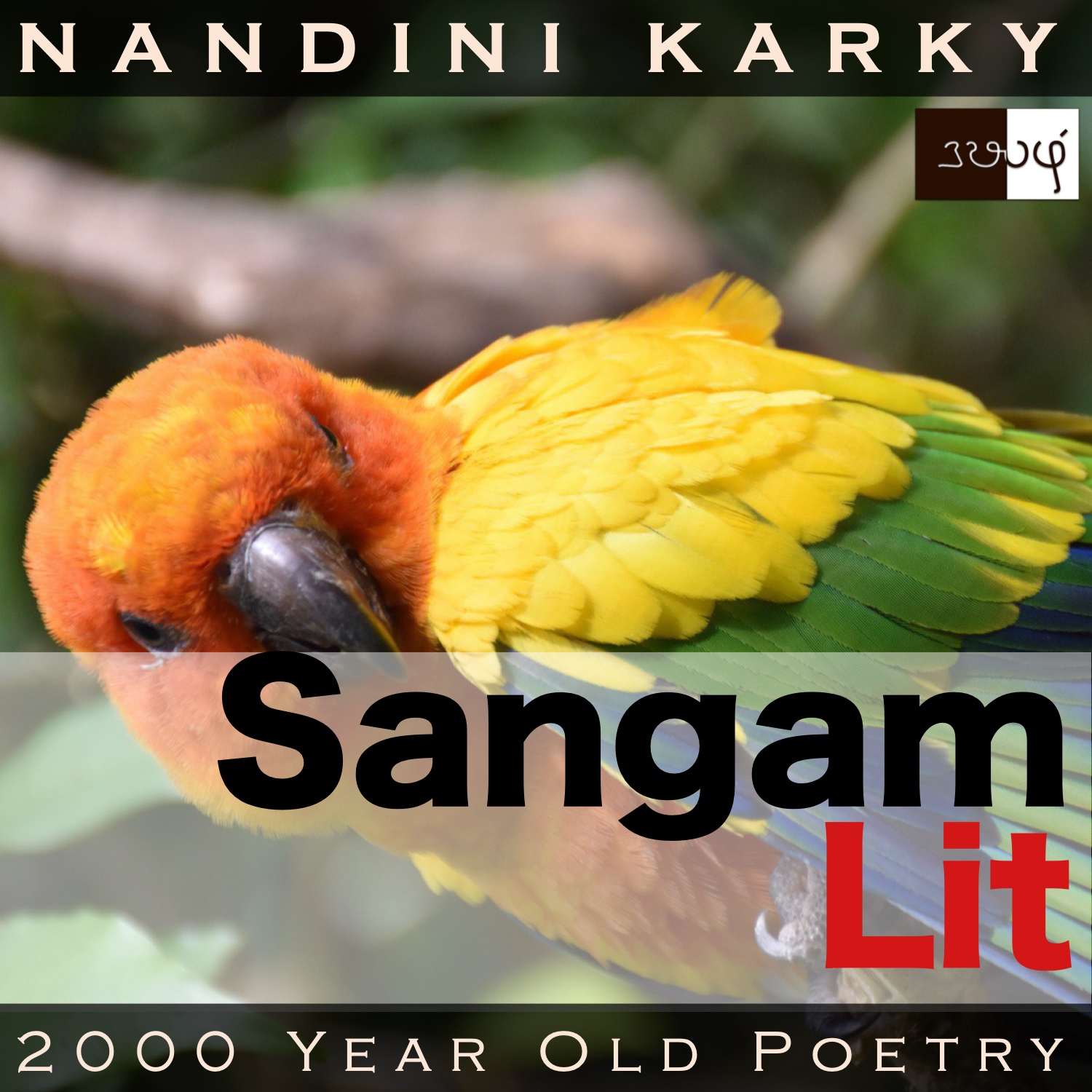Podcast: Play in new window | Download
Subscribe: Apple Podcasts | Spotify | Amazon Music | Android | iHeartRadio | TuneIn | RSS | More

In this episode, we take a walk through a millet field in a mountain country and perceive life and love therein, as depicted in Sangam Literary work, Natrinai 317, penned by Madurai Poovanda Naakan Vettanaar. Set in the hills of ‘Kurinji’, the verse speaks in the voice of the confidante to the man, subtly persuading him to seek the lady’s hand in marriage.
நீடு இருஞ் சிலம்பின் பிடியொடு புணர்ந்த
பூம் பொறி ஒருத்தல் ஏந்து கை கடுப்ப,
தோடு தலை வாங்கிய நீடு குரற் பைந் தினை,
பவளச் செவ் வாய்ப் பைங் கிளி கவரும்
உயர் வரை நாட! நீ நயந்தோள் கேண்மை
அன்னை அறிகுவள்ஆயின், பனி கலந்து
என் ஆகுவகொல்தானே-எந்தை
ஓங்கு வரைச் சாரல் தீம் சுனை ஆடி,
ஆயமொடு குற்ற குவளை
மா இதழ் மா மலர் புரைஇய கண்ணே?
The verse opens with ‘நீடு இருஞ் சிலம்பின்’ meaning ‘in the long and huge mountain range’ and transports us instantly to that hill country. ‘பூம் பொறி ஒருத்தல்’ describes ‘the beautiful spots on a male elephant’s face’, which we will discuss shortly. When we encounter ‘நீடு குரற் பைந் தினை’ meaning ‘long stalked new millets’, cultivation of crops becomes evident in that culture. The picturesque phrase ‘பவளச் செவ் வாய்ப் பைங் கிளி’ meaning ‘green parrot with a red mouth, akin to corals’ describes in exquisite detail, the visitors who frequent that millet field. A hypothetical situation is brought to the fore in ‘அன்னை அறிகுவள்ஆயின்’ meaning ‘if mother were to know’, which paints a Sangam mother in authoritative hues. Father too is not left behind, we learn when we glimpse at ‘எந்தை ஓங்கு வரைச் சாரல்’ which means ‘slopes around father’s soaring mountains’ and seems to claim the land for father! Ending with ‘மா மலர் புரைஇய கண்ணே’ which means ‘eyes like a huge flower’, the verse invites us to look within.
The man and lady had been leading a love relationship and the man had been trysting with the lady for a while. The confidante decides to impress on the man the need to formalise the union. So, one day, she says to him, “In the huge and vast mountains, a male elephant with beautiful spots unites with its mate. Akin to its raised trunk, tall stalks of new millets curve their heads. These millets are stolen by coral-mouthed, green parrots in your tall peaks, O lord of the mountains! If mother learns of your relationship with the one you love, do you know what would happen? In these mountain slopes belonging to father, she splashes in the sweet springs with her playmates and plucks blue lilies. Akin to the dark petals of that huge flower are her eyes and these will shed tears many, won’t it?” With these words, the confidante conveys the dangers ahead for the man and gently persuades him to seek permanent happiness.
Time to delve into the details! The confidante sketches for us a wildlife scene from the mountain country. Here, a male elephant with spots on its face is first spotted! A moment to meander and discuss this unique feature of Asian elephants, wherein once the males mature, that is reach around 15 to 20 years of age, they lose pigment on their skin and develop ‘freckles’. Although elephants care more about olfactory clues rather than visual ones in their mating behaviour, these freckles do no harm and have been transferred generation after generation in Asian elephants, from the time the group split from its African cousins, who do not have the same feature on their faces. This single phrase illustrates the acute observational skills of Sangam poets, who seem to not just be masters of the written word but ancient scientists too, experts on the natural world. Returning to the verse, this ‘freckled’ elephant is seen mating with its female and the confidante calls our attention to the raised trunk of the elephant. And this is called in, only to stand in parallel to the lush stalks of the millet crop. As we gaze at the millet crop, we see that it’s been stolen away by red-mouthed, green parrots, and the ‘red’ of their mouths is described with the aid of precious coral beads, illustrating the ancients’ familiarity with the same!
The confidante ends her narration of those scenes from the natural world as if only to describe the man’s mountain country. From this real world, she ventures into abstractions asking what might happen if mother came to know of the man’s relationship with the lady. She takes her time to elaborate first describing how the lady plays in the springs and cascades of father’s mountains. Here, an entire mountain range is being claimed in father’s name! The lady, as she is playing with her mates, is seen plucking a huge waterlily from those springs. From that real situation, the confidante yet again travels to an abstraction of what would happen to the eyes of the lady, which she equates to the blue lily in the lady’s hands and says, if mother were to know, the lady’s eyes would redden and flow with tears! By first presenting a joyous image of the lady playing and then shifting it to one where those beautiful eyes pour down with tears, the confidante intends to shock the man about the consequences of being discovered. Without saying so, she subtly persuades the man to avoid such untoward consequences in the one he loves. Akin to that parrot that steals its food from the field, she urges the man to take the right steps to claim the lady for himself. A verse that highlights the power of images to motivate and move someone in the right path!




Share your thoughts...